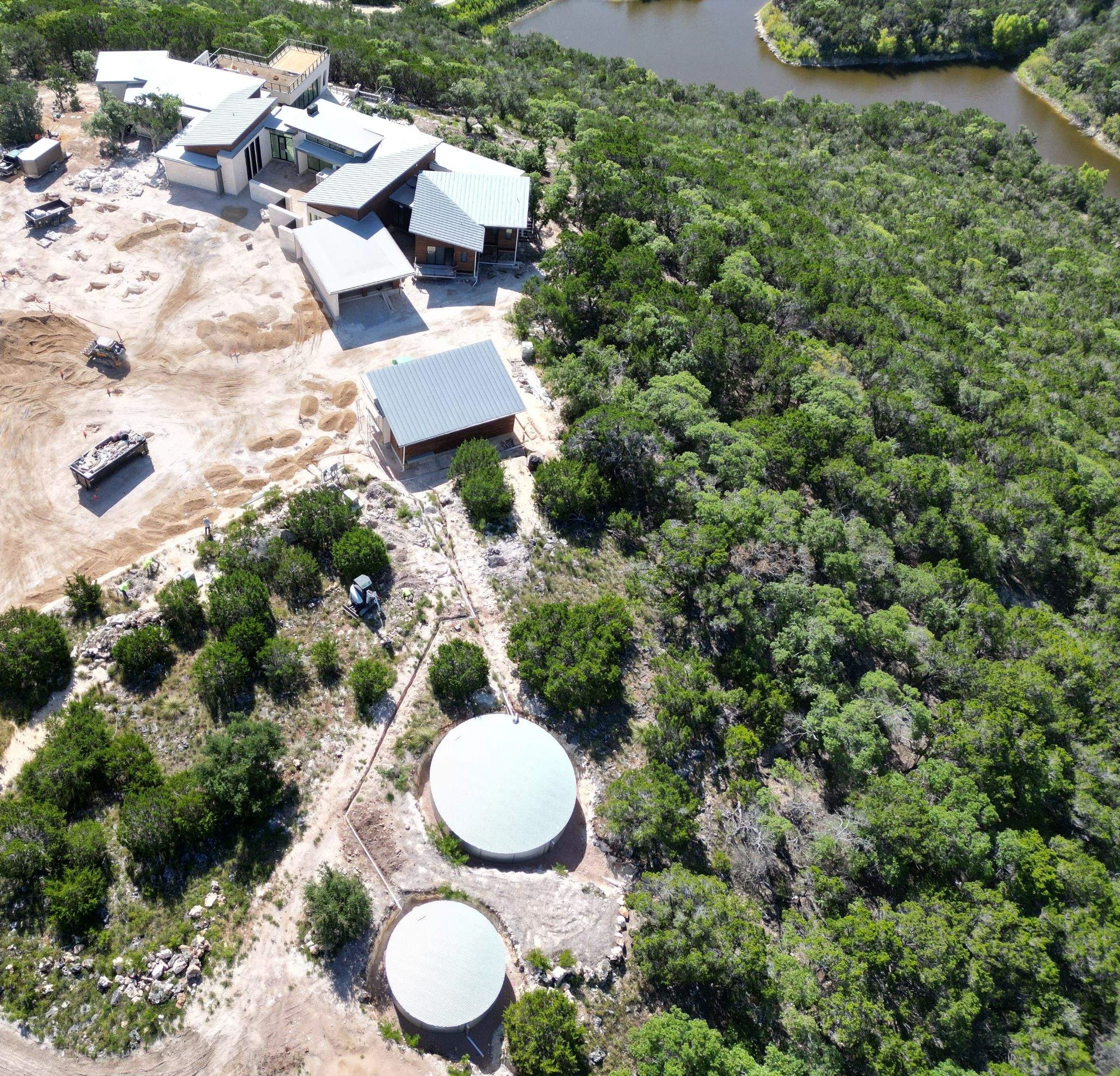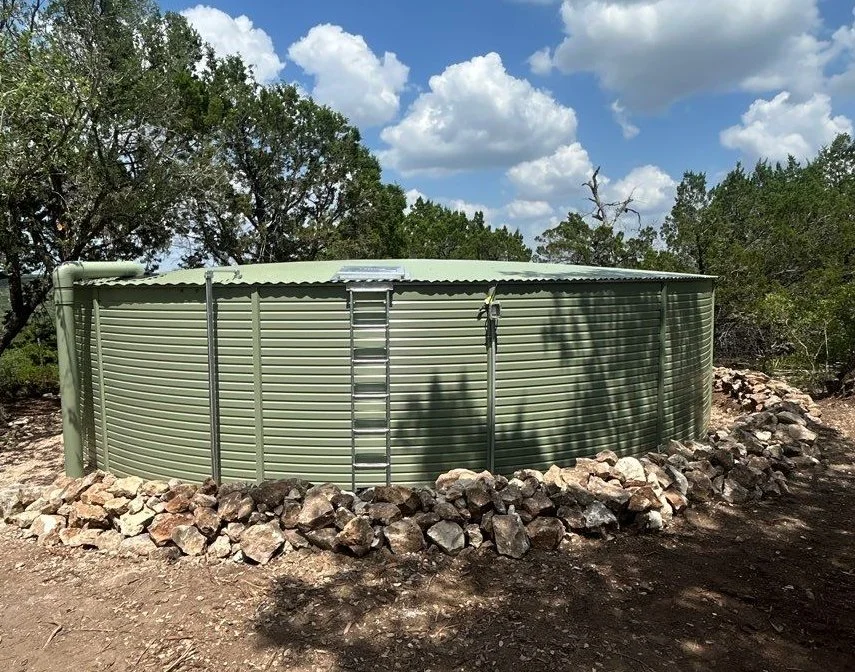
Invest in water security
Use our easy, no commitment calculator, enter a few details about your project, and get an estimate today

We understand that transitioning to rainwater can be a big investment. With so many options, and so many questions, we want to bring you a transparent approach to our pricing.
Did you know that in Central Texas, investing in a whole-home potable rainwater harvesting system can be less expensive than drilling a new well? More and more, homeowners are experiencing drops in water quality, or wells drying up altogether. Why not invest in a guaranteed source of clean, soft water that will be better for you -and you appliances- for years to come? Use our cost calculator below, and read on to learn more about what goes into a rainwater collection system.
What factors impact the cost of a rainwater system?
Roof Size: The larger the roof, the more pipe required to collect from the entire perimeter
The design of the roof and the footprint of the house: A single or double-pitch roof, such as a metal shop or barndominium, requires fewer runs of gutters, and fewer downspouts to collect the entire surface. On the other hand, a home with a complicated roof design with multiple pitches or gables will require multiple short gutter runs and underutilized downspouts to collect every section.
Tank size and location: Understandably, bigger tanks cost more than smaller tanks, but the price involves more than just the size. Bigger tanks require more land excavation, sand, and gravel due to the footprint of the tank, and there can be a higher labor cost due to the amount of installers required to install a 20k vs 65k gallon tank. Additionally, the more distance between the collection area to the tank, the higher the cost. While it may not be possible in every situation to place the tank beside your home, it is important to consider how the distance may affect the price. A longer distance requires more pipe for the collection, and potentially longer water and electrical lines. Depending on the natural grade of the property, there my be more excavation needs in order to get the necessary head pressure required for the system to operate. It may also change your pump needs, as a longer distance can require a more powerful pump to send water to your home.
Ground conditions: Texas has many different soil conditions, and the equipment needed for each can vary. Sites that require equipment like rocksaws, excavators, or jackhammers may increase costs compared to loamy soil conditions.
How can I mitigate costs associated with my rainwater harvesting system?
Capture from the most valuable and convenient sections of roof. If the total roof area of your structure allows, ditching complicated or undersized areas may make sense to reduce costs. Areas that require tunneling under sidewalks or cutting through driveways can require specialty equipment or subcontracting, which can increase costs. Additionally, small sections of roof that can’t be combined with bigger areas may not be worth adding additional downspouts, that won’t reach their max capacity, if the rest of the roof can meet your demands.
Work with your environment. We specialize in installing “wet” collection systems that rely on gravity to capture rainwater. Placing your tank in an area that is naturally downhill will mitigate excavation costs
Choose the best equipment for your needs. We focus on quality, so we don’t offer a “good, better, best” option when it comes to the equipment we install. We install Pioneer tanks, Luminor treatment units, and DAB pumps because we believe them to be the best products on the market. Investing in quality means long term savings with less maintenance, fewer repairs, and longer warranties. Choosing the best style for your needs can guarantee you are utilizing your system effectively and avoid the expense of needing to expand in the future.
Consider value vs price. The bottom dollar is important, there’s no doubt about that. It’s also important to consider what you’re getting for your investment. Below you’ll find a breakdown of price per gallon for our most common tank sizes. These prices are for the installation of a zincalume Pioneer Water Tank and do not include the cost of the system installation.
XLR 13/02 (16,392 gal capacity) $1.16/gal
XLR 15/02 (20,243 gal capacity) $1.03/gal
XLR 23/02 (29,093 gal capacity) $0.84/gal
XLR 30/02 (39,626 gal capacity) $0.83/gal
XLR 40/02 (51,785 gal capacity) $0.80/gal
XLR 50/02 (65,567 gal capacity) $0.72/gal
What influences our prices?
We use the best quality products on the market. There are many other metal tank companies, but we install Pioneer because we have seen the lasting quality they offer. They have been manufacturing metal tanks for over 35 years, and their original tanks are still standing strong. They come with a 20 year warranty, and they are the only tank installed with the Aquafresh antimicrobial liner. Their long-lasting materials withstand the test of time with minimal corrosion compared to other metal tanks.
We are invested in our employees. All of our field employees are full time and certified Pioneer installers who have collectively installed over 300 systems. Our prices reflect a living wage, benefits, continued education opportunities, and performance bonuses.
We own all of our equipment. From our trailers to our mini excavator, we own all the equipment we use. This lets us keep equipment and labor costs lower compared to renting, and means we never have to worry about availability.
We buy many of our products wholesale. We have great relationships with suppliers of our pipe and fittings, pumps, and treatment panels which means we’re able to get the highest quality products for the best price available.
Why are other companies cheaper?
Make no mistake, there are other great rainwater companies out there. We are so lucky to be in a network that supports each other and our shared mission of tackling Texas’s water crisis. However, not every company is created equal, and we have seen trends in the systems that don’t survive. Less durable pipe, like SDR rated PVC pipe, is less costly but breaks easily. We use Sch40 pipe which holds up better in high impact areas like tractor paths and driveways. Many companies build functional systems, but put no effort into aesthetics, leaving pipes unpainted. UV light is damaging to PVC pipe, and leaving the pipe unpainted can leave it brown and brittle. We take pride in building downspouts that aren’t just functional, they’re also custom painted to protect them from UV light and blend with the aesthetic of your home. We’re also there for you through the life of your system. When other companies stop answering calls, or close altogether, Cqure Water is there to help. We’ve been around for a long time and have helped many clients when other companies left them high and dry.
How much does a rainwater system cost?
There are a lot of variables, and you can use our cost estimator below to see what it may cost. Our average system for 2025 is between $45,000- $55,000.
What are the benefits to switching to rainwater?
If you’re building a new home, installing a potable rainwater system can be a better value that drilling a new well. That value extends beyond cost into security and peace of mind as well. After the drilling, pump, pressure tank, filters, and softener, most wells in Central Texas cost the same as installing a rainwater system, if not more. That’s if they hit water the first time. Many people have multiple holes drilled before finding water, each one adding another few grand to your bill. Then there’s never a guarantee on how long it will last.
Rainwater is dependable, stores well, and is easily treated. No more concerns about boil notices, water use limits, or monthly bill.
Hard water from wells, and even treated municipal water, can wreak havoc on your appliances, requiring constant upkeep and cutting their lifespan by up to 50%. Check out this article by Kinetico to find out how scale build up is affecting your appliances. Hard water isn’t just damaging to your appliances though, it also can cause skin irritation, dryness, dermatitis, plus dulling and breakage of hair. Rainwater is naturally soft, so there’s no scale buildup, no damage, and no need for a softener.
Our rainwater harvesting systems are designed to be low maintenance with few recurring costs. Outside of the energy consumption of the pump and treatment board, the only recurring cost is the annual replacement of your filters and UV light bulb. Cqure Water does offer this as a service, or you can check out our Rainwater at Home series on YouTube to learn how you can care for your system independently.
Outside of the personal and financial benefits, there’s also an environmental impact as well. By capturing and using your rainwater, you reduce the strain on surrounding wells and water treatment facilities. You also decrease storm water runoff that causes flooding and erosion.
Over the last five years, material costs, scarcity, cost of living, and tariffs have nearly doubled the costs of rainwater systems. By investing in your system today, you can lock in our pricing before it increases again. Continue to our calculator below to get a free estimate for your system!
Comal County- Potable System
XLR 30/02 ZINC (39,000 gal capacity)
12 downspouts
Tank located >200 ft from home
$75,000
Blano County- Potable System + Well Storage
XLR 30/02 ZINC (39,000 gal capacity)
XLR 15/02 ZINC (20,000 gal capacity)
8 downspouts
Tank located <150 ft from home
$90,000
Hays County- Potable System
XLR 30/02 Pale Eucalypt (39,000 gal capacity)
3 downspouts
Tank located <50 ft from home
$47,000
Bastrop County
XLR 50/02 ZINC (65,000 gal capacity)
12 downspouts
Tank located >100 ft from home
$77,000




